1994
Friday 11 February (and periodically until the end of the month)
The Mill Studio, Sussex England: time unknown. Recording: 'Free As A Bird'
(takes unknown); 'Real Love' (takes unknown); 'Grow Old With Me' (takes
unknown); 'Now And Then' (takes unknown).
P: George Harrison, John Lennon, Paul McCartney, Ringo Starr,
Jeff Lynne. E: Geoff Emerick.
When Paul, George and Ringo finally began their joint recording project in February 1994, they told insiders they were working on a "surprise". The nature of that
surprise leaked out at the start of March, when the New York Times reported that the trio were "adding new vocal and instrumental lines" to an unissued composing tape made by John Lennon in the late 1970s.
Paul: It was actually when the business problems got solved. The first thing we started talking about after the dust had settled was maybe we could do something together, maybe we don't have to live our lives completely separately from here on in. Just for the joy of getting together and doing something, Neil Aspinall at Apple said it could be an Anthology, the whole thing, CDs tracing the whole Beatles history.
George: Different ideas had been talked about, that we could do the background music or even write a new song or something.
Paul: I went off the idea of the three of us together.
Ringo: We took the easy route, which was to do some incidental music, because what else can we do? There were four Beatles and there are only three of us left. We were going to do some incidental music and just get there and play the instruments and see what happened.
Paul: But we never did get around to that. It just never felt like a good idea.
Ringo: Then we thought, well, why don't we do some new music? And then we always hit the wall, and OK, Paul had a song, or George had a song, or I had a song, well that's the three of us, why don't the three of us go in and do this. And we kept hitting that wall because this is the Beatles, it's not Paul George, and Ringo.
Paul: As the thought of the three of us actually sitting down in a studio started to get nearer and nearer, I got cold feet about it. I thought, does the world need a three-quarter Beatle record? But what if John was on, the three of us and John, like a real new record? If only we could pull off the impossible, that would be more fun. A bigger challenge.
Ringo: So Paul asked Yoko if there was anything of John's that never came out. Maybe we
could work with it.
Paul: She was a little suprised to get a phone call from me because we'd often been a bit adversarial because of the business stuff. She said she had these three tracks, including Free As A Bird.
Yoko Ono has revealed that it was actually George Harrison and Neil Aspinall who initially approached her with the idea to add new instrumentation and vocals to existing John Lennon
demos.
Paul: I went over to the place, the Dakota, sat up late just jawing and drinking tea and having fun and stuff. And she said, I should play you the tapes. And she played us three songs: Grow Old With Me, Free As A Bird, and Real Love. So it was good. Really emotional. I'd never heard them before but she explained that they're quite well known to Lennon fans as bootlegs. I said to Yoko, 'Don't impose too many conditions on us, it's really difficult to do this, spiritually. We don't know, we may hate each other after two hours in the studio and just walk out. So don't put any conditions, it's tough enough. If it doesn't work out, you can veto it.' When I told George and Ringo I'd agreed to that they were going, 'What? What if we love it?' It didn't come to that, luckily.
George: This became the perfect vehicle because we always had a thing between the four of us that if any one of us wasn't in it, we weren't going to get kind of Roger Waters and go out as the Beatles, so therefore the only other person who could be in it was John.
Paul: It seemed like we needed John and the more we thought of that the more exciting it became.
The three songs initially suggested by Yoko had already been heard before in public. Grow Old With Me was included on John's Milk And Honey LP; Real Love (Yoko's
favourite, perhaps because John's voice is clearer) was included on the Imagine documentary soundtrack; while Free As A Bird was broadcast on the US radio series The Lost Lennon Tapes.
In January 1994, when Paul came over to New York to induct John into the Rock Hall Of Fame, Yoko apparently gave Paul tapes of at least four John Lennon compositions (the exchange definitely involved more than three songs). Neil Aspinall claims he believes the transaction
consisted of "two cassettes" of John's songs, "It might have been five or six tracks." It's possibly at this stage that the fourth Lennon demo, entitled Now And Then, which had not been heard publically before, was handed over by Yoko.
Yoko: It was all settled before then, I just used that occasion to hand over the tapes personally to Paul. I did not break up the Beatles, but I was there at the time, you know?
Now I'm in a position where I could bring them back together and I would not want to hinder that. It was kind of a situation given to me by fate.
Paul: So I took the tapes back, got copies made for the guys and they liked it.
Ringo: And that's how it came about. It was just a natural thing which gradually evolved. It actually took about three years for all this to happen.
Paul: I played these songs to the other guys, warning Ringo to have his hanky ready. I fell in love with Free As A Bird. I thought I would have loved to work with John on that. I liked the melody, it's got strong chords and it really appealed to me. Ringo was very up for it, George was very up for it, I was very up for it. I actually originally heard it as a big, orchestral, forties Gershwin thing, but it didn't turn out like that. Often your first vibe isn't always the one. You go through a few ideas and someone goes
'bloody hell' and it gets knocked out fairly quickly. In the end, we decided to do it very simply.
The Free As A Bird late 1977 demo took off from a basic doo-wop chord sequence, taking in some of the stately changes of Grow Old With Me as it progressed. Agonisingly slow, it was written at the piano around a maudlin set of chord changes that virtually guaranteed an air of sadness. The lyrics, certainly incomplete, explored different ways of conveying the metaphor of the title, quite clearly it was the concept rather than any particular lyrical
phrase which had been the initial inspiration. Lennon filled the second half of his demo with wordless vocal lines and repetitions of the title phrase, picked up by the tiny mike of a portable tape player placed on top of his piano.
John recorded at least two, possibly three, piano backed demos of Free As A Bird (and in 1998 there were reports than an acoustic guitar demo of the song had also been discovered). This was a tune of great promise that seems to have been written at the
piano one day, preserved on tape and forgotten by John. But
despite its incomplete lyrics, it had an air of majesty that deserved further
attention. What stayed in the mind was the mood, an air of phoenix-like hope
drifting uncertainly out of a fog of depression - and that haunting melody.
Paul: It's crazy really, because when you think about a new Beatles record, it is impossible, because John is not around. I invented a little scenario; he's gone
away on holiday and he's just rung us up and he says "Just finish
this track for us, will you? I'm sending the cassette - I trust you."
That was the key thing, "I trust you, just do your stuff on it."
I told this to the other guys and Ringo was particularly
pleased, and he said "Ahh, that's great!" It was very
nice and it was very irreverent towards John. The scenario allowed us to be not too, ahh, the great sacred fallen hero. He would never have gone for that. John would have been the first one to debunk that - "A fucking hero? A fallen hero? Fuck off we're making a
record."
Ringo: At the beginning it was very hard, knowing that we
were going in there to do this track with him. It was pretty emotional. He
wasn't there. I loved John. We had to imagine he'd just gone
for a cup of tea, that he's gone on holiday but he's still here. That's the only
way I could get through it.
Paul: Once we agreed to take that attitude it gave us a
lot of freedom, because it meant that we didn't have any sacred view of John as a martyr, it was John the Beatle, John the crazy guy we remember. So we could laugh and say,
'Wouldn't you just know it? It's completely out of time! He's always
bloody out of time, that Lennon!' He would have made
those jokes if it had been my cassette.
George: Because it was only a demo he was just plodding
along and in some places he'd quicken up and in some places he'd slow down.
Production duties for the sessions were shared not by George Martin,
but by George Harrison's fellow Traveling Wilbury, Jeff Lynne.
Paul: George (Martin)
wasn't involved, no. I was originally keen to have George do
it. I thought it might be a bit insulting not to ask him to do this. But
George doesn't want to produce much anymore because his
hearing's not as good as it used to be. He's a very sensible guy and he says,
'Look Paul, I like to do a proper job,' and if
he doesn't feel he's up to it he won't do it. It's very noble of him, actually,
most people would take the money and run. Plus
George Harrison was keen to make sure we had someone really
current with ears. He knew Jeff Lynne. I was worried there
might be a bit of a wedge but in fact it wasn't like that, it was great.
Jeff worked out really well. As I said to him, a lot of people
are very wary of your sound. I said, you've got a sound. He said, Oh have I?
He's got a way of working but it's very similar to some of the ways we worked in
the Beatles.
Ringo: We started off with a cassette that
Yoko gave us, but the cassette wasn't in the greatest
condition.
Paul: We took a cassette of John's, it
was him and piano, interlocked. You couldn't pull the fader down and get rid of
the piano.
Lynne contacted Marc Mann, an LA studio musician, to assist him in cleaning up the tapes. Mann recalls that the cassettes used were very old and very noisy (others involved, however, claim that Yoko handed over copies of the original cassettes, not the originals themselves).
Lynne: It was very difficult and one of the hardest jobs
I've ever had to do because of the nature of the source material. It was very
primitive sounding, to say the least. Free As A Bird however, wasn't
as quarter as noisy as Real Love, and only a bit of EQ was needed to
cure most problems. I spent about a week at my own studio cleaning up both
tracks on my computer. So it took a lot of work to get it all in time so that
the others could play to it.
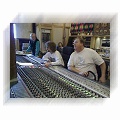
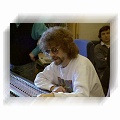
Using DINR (Digidesign), Logic Audio (Emagic) and Studio Vision (Opcode) running on a Macintosh computer loaded with ProTools (Digidesign), Marc Mann edited and otherwise massaged the tapes. The pre-production work done by Lynne and Mann was pretty heavy duty, and a dummy of the anticipated final recording was done to see if the concept would actually work before Paul, George or Ringo played a note.
The cassette was dumped to a hard drive and all the processing necessary to clean up the audio was done first (among other things, there was apparently massive tape hiss). The dummy temp tracks (played by Lynne, Mann and other studio musicians) were sequenced with the original in Studio Vision to see what the final product
might sound like.
Paul: Before the session we were talking about it, and I
was trying to help set it up, because we never even knew if we could be in a
room together, never mind make music together after all these years. So I was
talking to Ringo about how we'd do it, and he said it may even
be 'joyous'. We'd not met for a long time, and the press didn't
bother us because nobody guessed we'd be down there.
Another reason for the secrecy may also have been safety. One of the effects of John's death was that the three remaining Beatles became highly concerned about security matters. Any advance announcement that the group were getting together, even 'behind closed doors', would have brought out not only hoards of fans and press photographers, but it would also have been an invitation to any nutter who personally considered George, Paul and Ringo targets.
Lennon's son Sean, 20, had warned
McCartney, "It's going to be a bit spooky hearing
a dead guy on lead vocal. But give it a try."
Paul: We know we can't do anything better than the
Beatles, but for old time's sake, we thought it would be nice
to give it a whirl.

George, Jeff, Paul, Ringo.
George, Paul and Ringo
eventually began work at The Mill, McCartney's Sussex studio,
in February 1994, thirty years to the day since they'd played their first US concert at the Washington Coliseum (probably mere coincidence, although the date may have been specially chosen; it is known that an original set of sessions booked to begin on 11th January had to
be cancelled when Ringo went on a skiing holiday!).
Set in a converted windmill on a hill, the studio overlooks, beyond some
gently rolling farmland, the English Channel. Around the coastal sweep is a
nuclear power station, but the location is otherwise idyllic. It's also quite
remote, which helped preserve the virtual secrecy that surrounded this reunion.
In a corner outside the control room, with an aging map of Liverpool on the
wall, was popped one of Paul's treasures, the upright double
bass that belonged to Bill Black of Elvis Presley's
original combo. McCartney, in passing, would sometimes pluck
it for luck.
Paul:
We agreed to do it at my studio because this is really the only
studio that was up and running. I'd been working here regularly so it was
all cleaned and ready to go and in full working order. Also, because my
studio is slightly off the beaten track - off the Beatle track! - it meant
that we'd have privacy. And the press were doing a lot of talk at the time -
"It'll be in Abbey Road" - and we figured they'd be watching places like
that. So this became the perfect place to do it and we were very lucky both
the times we did it: we didn't have anybody notice that the guys were here,
and I accommodated them all locally so the word didn't get out too much.
George, Paul and Ringo were adamant that analogue equipment and die hard techniques should be
used wherever possible. The Beatles experimented on several of the songs Yoko had given them (whether such experiments were actually recorded is unknown) before deciding to focus their attentions on Free As A Bird.
Paul: We just started listening to the
cassette, which, as you know, was just a mono cassette with John's voice and
his piano locked in. Anyone who knows anything about recording knows that,
for a mix, you try to isolate the voice and the piano on separate tracks to
give yourself a bit of control. But we had a fixed tape. First of all,
George and I tried to put some acoustics on, and play along with it as it
stood, because we wanted to be as faithful as possible to the original. But
because he was doing a demo John went out of time a bit. Unless you're
working to a click track you don't concentrate on tempo when you're doing
demos. And because he was trying to find the song on the demo the
middle-eights weren't filled out, lyrically. His vocal quality was nice and
he'd put a funny phasing effect on, which there was no getting rid of, but
it was a nice effect actually, very Sixties, very evocative. I think it's
one of the things that gives the record a nostalgic feel. But eventually,
because George and I had to keep looking at each other and giving signs
through our eyes, like "he slows down here, he speeds up here", it became
difficult. It became quite annoying to try and keep up with the speed
changes.So it was decided that we had to take another approach. We had
to isolate John's voice as best we could and then lay it back in on the tape
to a click track that would not be heard on the record but would be strict
tempo. Jeff Lynne and the engineers did that.
The final pre-produced tracks were then sent back to McCartney's England studio on DAT – Lennon's voice and piano in the left channel, a click track in the right channel (Ringo used the click to add live drums).
Ringo: Jeff Lynne did a great job putting it into time and cleaning it up. Only then could we
begin overdubbing.
Paul: Once that had been done we were able to play with it because John
was now perfectly in time and there were just little gaps where he'd sped up
or gone out a bit.
After that we did acoustic guitars and I learned John's piano
part. I'd been studying it a little bit the week before we did the session,
and Jeff Lynne had studied it very hard and showed me one or two interesting
little variations that John had put in there, that I hadn't picked up. Then
I played it - John and I had very similar piano styles because we learned
together - which meant that we now had a voice and a piano separate and
could get control over them.
Then I put the bass on, which I kept very, very simple: I didn't
want to do any of my trademark swoops or get it too melodic, I just wanted
to anchor the piece. I did one or two little tricks but they're very subtle,
like I used my five-string bass, which has got a very low string on it, and
saved the low string till the tune does a big key change in the solo, and it
really lifts off there. So instead of doing the same bass note I went right
down to my second lowest note on the instrument. Then Ringo did some great drumming on it, and Jeff Lynne - being
very, very precise - made sure that every single snare was exactly correct
and he and the engineer Geoff Emerick got a really great sound.
McCartney says there was some tension between him and
Harrison when it came time to write a few new lines for the
song but it passed quickly.
Paul: When we were working on Free As A Bird
there were one or two little bits of tension, but it was actually cool for the
record. for instance I had a couple of ideas that he didn't like and he was
right. I'm the first one to accept that, so that was OK.
Lennon had left one half-finished verse behind: "Whatever
happened to/the life that we once knew?" George
and Paul finished it off and took turns singing the first new
verse in decades: "Can we really live without each other?/Where did
we lose the touch?/It seemed to mean so much/It always made me feel so..."
Paul: John hadn't filled in the middle
eight section of the demo so we wrote a new section for that, which, in fact,
was one of the reasons for choosing the song; it allowed us some input, he was
obviously just blocking out lyrics that he didn't have yet. When he gets to the
middle he goes, 'Whatever happened to / The life that we one knew /
Woowah wunnnnn yeurrggh!' and you can see that he's trying to push lyrics
out but they're not coming. He keeps going as if to say 'Well, I'll get
to them later'. That was really like working on a record with John,
as Lennon/McCartney/Harrison,
because we all chipped in a bit on this one. George and I were
vying for best lyric. That was more satisfying than just taking a John
song, which was what we did for the second, Real Love. It worked out
great but it wasn't as much fun.
George: If you hear the original version you know that
John plays very different chords changes in it as well.
Historically, what we'd say would be,
'Well, hang on, I'm not too sure about that chord there, why don't we try
this chord here?' So we took the liberty of doing that, of beefing the
song up a bit with some different chord changes and different arrangements.
Paul: It was the nearest I was
ever going to get to writing with John again.
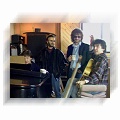
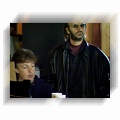
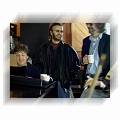
Soon, Lennon's high, wavering voice was in their
headphones. 'Free as a bird / It's the next best thing to be / Free as a
bird / Home, home and dry / Like a homing bird I'll fly'
Paul: It was very good fun for me to have John
in the headphones when I was working, it was like the old days and it was a
privilege.
Ringo: We were all hanging out together in the studio, but
we didn't do it like we used to. Back then, the four of us would just kick in
and get the backing track. We couldn't do that.
By now, John's original mono cassette had been expanded into analogue
48 track form.
Ringo started the song off with two beats on snare. George
broke in with a bluesy slide guitar riff and continued with a slide solo. The
demo was further augmented with George's and Paul's
acoustic guitars, Paul's bass guitar and new vocals from George,
Paul and
Ringo. Paul also doubled the piano part to the point where there wasn't much left of
John's original playing. Jeff Lynne added harmonizer chorus to that piano to blend it in.
Marc Mann: You can hear a little bit of mid-range color coming in when John sings . . . that's the piano.
Paul: We just got on with it, and treated it like any old
tune the
Beatles used to do, fixed the timing and then added some bits.
George played some great guitar, we did some beautiful
harmonies. What I liked was I played very, very normal bass, really out of the
way, because I didn't want to 'feature'. There are one or two moments where I
break a little bit loose, but mostly I try to anchor the track. There's one
lovely moment where it modulates to C, so I was able to use the low C of the
five-string. That's it, the only time I use the low one, which I like, rather
than just bassing out and being low, low low. I play normal bass, and there's
this low C and the song takes off. It actually takes off anyway because a lot of
harmonies come in and stuff, but it's a real cool moment that I'm proud of.
George: We did the total new record, then we just took his
voice and we dropped it in every line where we needed it until we built up the
lead vocal part.
Lynne: Although a long time has passed since they last
recorded as one unit, they worked terribly well together. Being in the control
room watching and listening to them interact with each other was fascinating.
Paul and George would strike up the backing
vocals and all of a sudden it's the Beatles again. They were
having fun with each other and reminding each other of the old times. I'd be
waiting to record but I was too busy laughing and smiling at everything they
were talking about. It was a lovely, magical time. But it was very scary because
it had never been done before and there were no points of reference. What do you
do on a Beatles record when the singer's not there?
Paul: It came to the backing harmonies and George
said to me ' Jeff is such a big Beatles
fan, he'd love to get on this record, he'd just die! Even if he goes 'hey!' he
can then say he was on it'. And I was a little bit reluctant. I'm a bit
sort of precious, a bit private about who's in the Beatles and
we didn't do too badly on that philosophy. Even when Billy Preston
came in I was in two minds. The others were so definite that I went with their
thinking, as I always did, because I knew they had right-on opinions. Well
Ringo says 'You know why ELO broke
up? They ran out of Beatles riffs.' One off Jeff's
great prides is that he met John once - obviously a huge fan
of John's - and John said 'I really
like all that ELO stuff man.' That was the highspot of
Jeff's life! He was vindicated. John said it
was alright! So we got Jeff on Free As A Bird.
At the time, Ringo was reported as saying that the reunion sessions, which had been planned to last a week, had
gone "much better than expected" and had been extended right until the end of the month (where work may also have briefly commenced on Now And Then and Grow Old With Me).
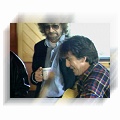
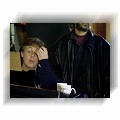
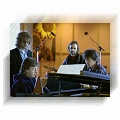
Paul: I am quite proud of it. I think it worked great,
it's actually a Beatles record. It's spooky to hear John
singing lead, but it's beautiful. People said beforehand we shouldn't do it, but
that kind of focused us up a bit. I thought, fuck you! We'll fucking show you!
It's fatal if they come out in the papers and say we shouldn't do it, because I
want to do it even more. It was a joyful experience, it was magic, it was a
really good laugh to be making music together again. Me and
George ended up doing harmonies and Ringo's
sitting in the control room. He says, 'Sounds just like the Beatles!' It finally did, really, sound like a Beatle record, and we were becoming more
and more convinced that we were doing the right thing.
Ringo: Oh I was shocked, it just blew me away. I don't
know why I didn't think it is us anyway, but, I just had a moment there of being
far enough away from it to look at it like a real thing. And it's just like
them, it was a mind blower. It sounds like the bloody Beatles,
it sounds like a Beatles track. It could have been recorded in
1967. So much has gone down since those days, twenty odd years ago, but when I
played the track, I thought, 'Sounds just like them!' Of course it
does, because we're on it. Doing this project has brought us together. Once we
get the bullshit behind us, we all end up doing what we do best, which is making
music!
Paul: It was better when there were three of us than when
Ringo said "Oh I've done my bit" and
left me and George to do it. Me and George ,
as artists, we had a little bit more tensions. But I don't think that's a bad
thing. It was only like a normal Beatles session; you've got
to reach a compromise.
There are banks of Harrison/McCartney harmonies
which support the wordless Lennon vocals, and a majestic
Harrison solo that leads the track from a Starr
drumbreak to the end of the song.
Paul: We pulled it off, that's the thing, and I don't care
what anyone says. We could work together. We did a bit of technical stuff on
tape, to make it work, and Jeff Lynne was very good. We had
Geoff Emerick, our old Beatle engineer; he's
solid, really great. He know how Ringo's snare drum should
sound.
The end of the track features Lennon muttering ther old George Fromy catchphrase "Turned out nice again" to tie in with some ukulele playing Harrison had taped for the outro.
Paul McCartney: There is real magic going on. On the end of 'Free As A Bird', just for a joke - in
case people were thinking, "God, they really mean it, this is so serious,
this isn't like all their other records, this is serious homage" - we
re-entered with the drums, then George did his George Formby stuff on the
ukulele and then, to even take it one stage further, we put in something
backwards. We got the guys at the film production office to find a clip of
John talking - we gave them a certain phrase to look for, which I'm not
giving away - and then we put it in backwards, just as little joke, a bit of
fun that ties in with the ending. Anyway, the incredible thing is, the other
day Eddie [Klein, Paul's studio manager] was working on the tape and he
said, "Paul, listen to this" and he played it to me and, I swear to God, the
backwards stuff says, "Made by John Lennon". None of us had heard it when we
compiled it, but when I spoke to the others and said "You'll never guess..."
they said, "We know, we've just heard it too". They'd heard it,
independently. And I swear to God, he definitely says it! We could not in a
million years have known "what that phrase would be backwards. It's
impossible. So there is real magic going on. Hare Krishna!
Geoff Emerick: We hadn't seen each other or been together
in 25 years, and suddenly we were all working like before. The old magic was
there instantly.
Paul: And there was a kind of crazy moment, thinking, oh
yeah, 'cause, not having done it for so long, you become an ' ex-Beatle '.
But of course getting back in the band and working on this Anthology,
you're in the band again. There's no two ways about it. And it was good, it was
good being them again for a little while. We work well together, that's the
truth of it, we just work well together. And that's a very special thing. When
you find someone you can talk to, it's a special thing. But if you find someone
you can play music with, it's really something, y'know.
George: It was interesting to actually get back together.
For Ringo, Paul, and I, we've had the
opportunity to let all the past turbulent times go down the river and under the
bridge and to get together again in a new light. I think that has been a good
thing, it's like going full circle, and I feel sorry that John
wasn't able to do that, because I know he would have really enjoyed that
opportunity to be with us again.
Most of the track was completed by the end of February with the addition of
George's closing guitar part.
Paul: I was worried because it was going to be
George on slide. When
Jeff suggested slide guitar I thought (dubiously), it's My
Sweet Lord again, it's George's trademark. John
might have vetoed that. George started to work on his guitar parts, and he did a
secondary guitar part, between a lead and a rhythm, sort of arpeggio rhythm
you'd have to call it. He came up with some nice little phrases there which
are very subtle on the record: I tend to hear them about the third time
through. And then finally he came up with his slide guitar. I told Jeff
Lynne that I was slightly worried about this because I thought it might get
to sound a little bit like My Sweet Lord or one of George's signature
things. I felt that the song shouldn't be pulled in any way, it should stay
very Beatles, it shouldn't get to sound like me solo or George solo, or
Ringo for that matter. It should sound like a Beatles song. So the
suggestion was made that George might play a very simple bluesy lick rather
than get too melodic. And he did: what he played was almost like a Muddy
Waters riff. And that really sealed the project. I thought - I still think -
that George played an absolute blinder, because it's difficult to play
something very simple, you're so exposed. But it was fantastic and Jeff
Lynne and Geoff Emerick got a great sound on him. In fact he got a much more bluesy attitude, very
cool, very minimal, and I think he plays a blinder.
Free As A Bird is really emotional. I've played it to a few people
who've cried, because it's a good piece of music and because John's
dead. The combination of that can be emotional. But I love that. I don't have a
problem with something that grabs you by the balls so you've gotta cry. I rather
respect that. We did the end bit, put little extra vocal
things on that, and then the ukuleles, which was a tip of the hat to George
Formby, whom George is particularly enamoured of. And I like
George Formby a lot too, he's a great British tradition - and John's mum,
Julia, used to play the ukulele so I suppose there was a point of contact
there too. And then we got the phrase of John's to turn backwards, laid it
into the mix and thought, "That's it, it really sounds like a Beatles
record." And so that was it
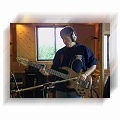
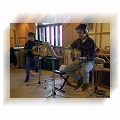
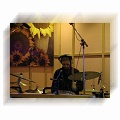
George: Free As A Bird does sound like the
Beatles, only a more modern version. But we went through a lot
of changes musically in the 1960s so it's hard to actually put your finger on
what was the Beatles sound. When you say it sounds like the
Beatles, people may expect it to sound like 65 or 68. It's
very similar in some respects to Abbey Road because
it has the voicing, the backing voices like Because. But the whole
technical thing that has taken place between 1969 and 1995 is such that, you
know, it sounds a lot more like now.
Paul: No, we didn't go "We'll go for
Beatles circa 1967." It was Beatles
now.
Julian Lennon: I heard the song for the first time when I
was last in New York visiting Sean and Yoko.
It's a great song. I love it. Although I must say I find it hard to hear Dad's
vocals.
Paul: When George Martin heard it he was very pleased with it, so that was nice.
George Martin: They stretched it and compressed it and put it around until it got to a regular waltz control click and then they were done. The result was that in order to conceal the bad bits they had to plaster it fairly heavily so that what you ended up with was quite a thick homogeneous sound that hardly stops.
The Beatles rounded off with a trip to the local pub and a
visit to Paul's neighbour, Spike Milligan.
Paul: When we'd done it, I thought, we've done the
impossible. Because John's been dead and you can't bring dead
people back. But somehow we did - he was in the studio.
George: We always said the Beatles was
us four and if ever one of us wasn't in it then it's not the Beatles,
and the idea of having John as the singer on the record, it
works, it is the Beatles . There was talk about us doing stuff
on our own but I have no desire really to do a threesome.
When the Anthology DVDs were released in 2003, some video footage from these inital Free As A Bird sessions was included on a bonus disc (it's easily differentiated from the later Real Love footage as George has no beard at this point). The group can be heard rehearsing the song and discussing the chord structure.
Paul: The only recording session I've ever written about
was Free As A Bird. It was an exciting week and shortly afterwards I
went on holiday to America. On the plane I wrote down what had gone on at the
session. Just to remember the facts really, before they were forgotten.
Sources include: Apple Corps Free As A Bird Press Releases; Q
Magazine Dec 95, Jun 97; Club Sandwhich Magazine; Keyboard Magazine Apr 1996; The Art And Music Of John Lennon
( John Robertson - Omnibus Press); The Beatles (Hunter Davies - Jonathan Cape Ltd); The Beatles After The Breakup (Keith Badman - Omnibus Press); Interview With Paul McCartney Beatlefan Magazine #97 Nov-Dec 1995; Today Night (Seven Network
Australia); Mojo Magazine Nov 95, Jun 97; Daily Mail Nov 95; Beatles Monthly No.
214 Feb 94, No. 216 Apr 94, No.218 Jun 94, No. 220 Aug 94 , No. 228 Apr 95, No.
231 Jul 95, No. 236 Dec 95, No. 242 Jun 96, No. 249 Jan 97 (Beat Publications
Ltd)
Main Contents
Next Entry : 22 June 1994 Session